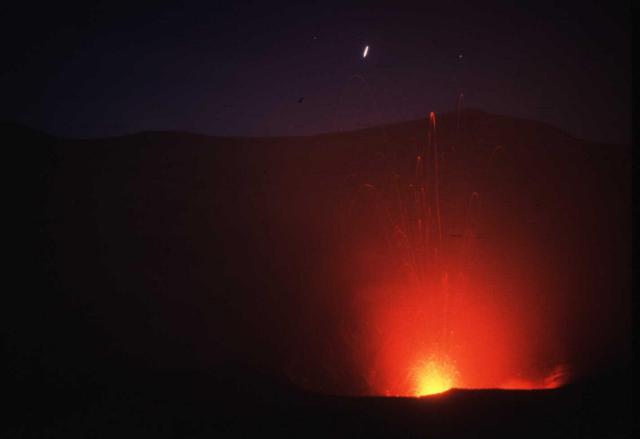Report on Yasur (Vanuatu) — August 1997
Bulletin of the Global Volcanism Network, vol. 22, no. 8 (August 1997)
Managing Editor: Richard Wunderman.
Yasur (Vanuatu) Mid-August visit discloses ongoing Strombolian eruptions from six vents
Please cite this report as:
Global Volcanism Program, 1997. Report on Yasur (Vanuatu) (Wunderman, R., ed.). Bulletin of the Global Volcanism Network, 22:8. Smithsonian Institution. https://doi.org/10.5479/si.GVP.BGVN199708-257100
Yasur
Vanuatu
19.532°S, 169.447°E; summit elev. 361 m
All times are local (unless otherwise noted)
On 13 August 1997, Steve O'Meara and Robert Benward climbed Yasur from the NE (the Sulphur Bay side); they camped for two evenings on the volcano's summit at the E lip of the main crater (figures 8, 9, and 10). On 16 and 17 August they hiked on the S side of the volcano up to 150 m from the summit where they watched the eruptions for two hours each night. They shot video footage of dramatic, night-time intracrater activity abundant molten bombs hurling inside the crater, with many sticking to the steep crater walls. Reported explosion heights were determined by timing the fall of a fragment from the apex of its curve and using the equation x = 1/2 gt2.
 |
Figure 8. Photograph of Yasur showing a dual ash eruption from the S and N craters; sunset, 13 August 1997. View is from the E. Courtesy of Stephen and Donna O'Meara. |
 |
Figure 9. Photograph of Yasur showing a thin 150-m-high explosion in the N crater; early morning, 14 August 1997. View is from the E along the Jupiter trail. Courtesy of Stephen and Donna O'Meara. |
 |
Figure 10. Photograph of Yasur showing a wide-angle view of the summit with Strombolian activity in the N crater; dusk, 14 August 1997. View is from the E. Courtesy of Stephen and Donna O'Meara. |
The interior of the crater sloped sharply inward to a depth of ~70 m, where it intercepted a broad platform of ash punctuated by two roughly equally sized, oval-shaped craters, each ~70 m in diameter and 70 m deep. The craters were aligned N-S, and separated by an E-W trending ridge of ash. Each crater had three erupting vents.
North Crater observations. The active vent on the far E floor continuously spewed lava fragments 10-20 m high with coughing and splashing sounds. Occasionally a web-like bubble of lava rose out of the vent and burst as it expanded. Small puffs of steam and ash accompanied some of the more forceful discharges of gas. Several times during 13-15 August Strombolian explosions shot lava fragments 100-170 m into the air. One of the strongest explosions, on 15 August, directed ENE, showered the summit with volcanic bombs. One football- sized bomb fell ~30 m from the observers who collected it and donated it to the Smithsonian Institution. This explosion was followed by a sequence of blasts at intervals varying between 15 minutes and a few hours. As a qualitative measure of the explosions' intensity the observers reported that some of the strongest ones shook the ground, and they could feel the shock waves pound against their chests.
Two other vents were located on the SE and SW parts of the crater floor. These issued sporadic, small columns of ash rising to heights of ~100 m before dispersing in the high winds at the summit.
On the night of 16 August the N crater was still continuously spattering. The following night two blasts threw fragments ~200 m above the crater.
South Crater observations. This crater produced ash clouds from three vents, (two in the E- central section and one on the W side of the crater's floor). On 13 August the emissions were almost continuous; the central vents appeared to be filled with ash and the eruptions started as a boiling up of ash that sent ripples out from the center. As the ash column formed, a shower of incandescent rocks rose within it to a height of ~15 m before the fragments rained back down into the vent. In general these eruptions were relatively silent, sounding like sand being dumped from a truck, followed by the thudding of rocks as they hit the ground. Distinct snapping sounds occurred ~ 2 seconds after the incandescent rocks began rushing up the ash column, possibly due to static discharge. Within the next 24 hours the W vent became gradually less active, and the two central vents merged into a single larger vent.
During the two observation periods on 16 and 17 August the S crater was extremely active with explosions every 10 to 15 minutes. The sounds rivaled those of the strong Strombolian explosions from the N crater.
Geological Summary. Yasur has exhibited essentially continuous Strombolian and Vulcanian activity at least since Captain Cook observed ash eruptions in 1774. This style of activity may have continued for the past 800 years. Located at the SE tip of Tanna Island in Vanuatu, this pyroclastic cone has a nearly circular, 400-m-wide summit crater. The active cone is largely contained within the small Yenkahe caldera, and is the youngest of a group of Holocene volcanic centers constructed over the down-dropped NE flank of the Pleistocene Tukosmeru volcano. The Yenkahe horst is located within the Siwi ring fracture, a 4-km-wide open feature associated with eruption of the andesitic Siwi pyroclastic sequence. Active tectonism along the Yenkahe horst accompanying eruptions has raised Port Resolution harbor more than 20 m during the past century.
Information Contacts: Stephen O'Meara, Donna O'Meara, and Robert Benward, Volcano Watch International, Nature *Stock, PO Box 218, Volcano, HI 96785, USA.

